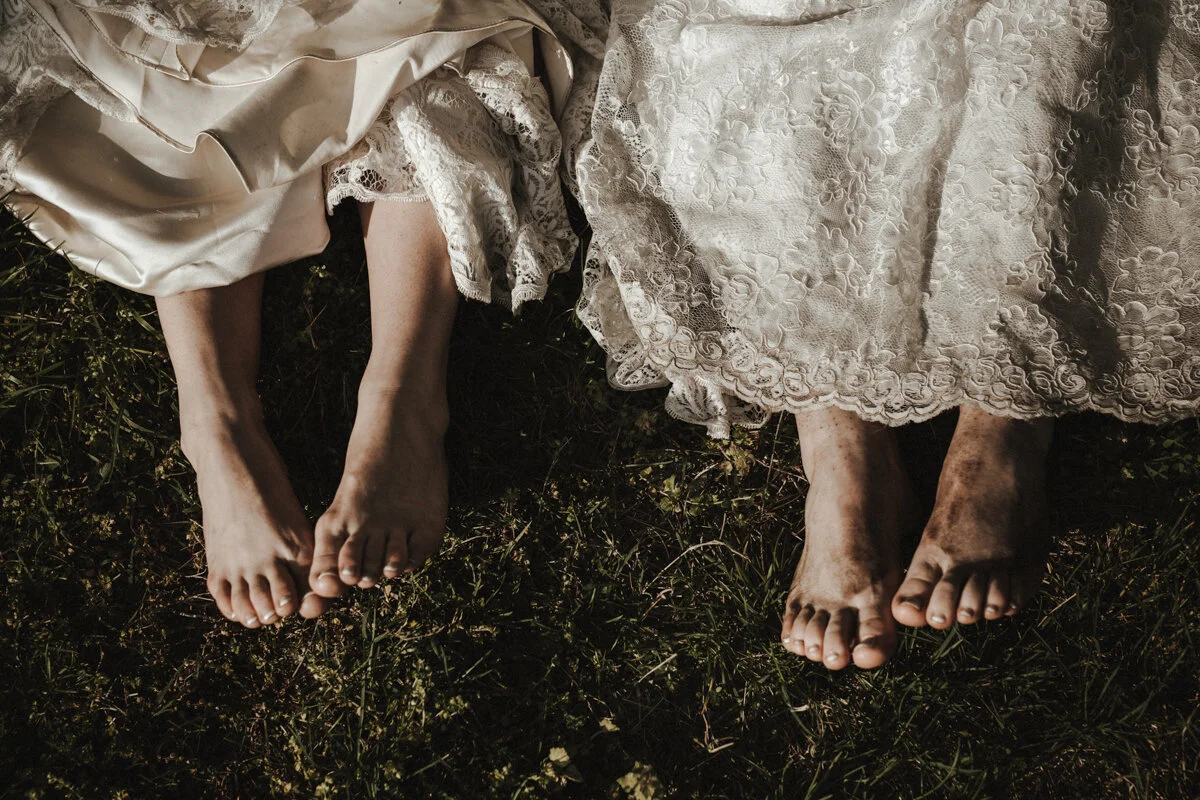Trading White Lace For Red Silk: How I Found a Wedding Dress that Truly Fits Me
/This post contains affiliate links. Catalyst Wedding Co. may receive compensation or products from companies linked to or mentioned in this article. This helps support our site.
All Photos by Leslie Rodriguez
No lace. No beading. No cleavage-showing. And no white. Those were my only preferences when it came to wedding gowns.
Allison, my fitting consultant, looked confused. Her thick, brown brushstroke of an eyebrow twisted like a question mark. I was seated on an ivory velour bench of a premiere bridal boutique, Wedding Atelier, in Manhattan, for a one-hour appointment that my friend Karol had booked. As soon as I got engaged, Karol declared that shopping for a bridal gown with me was something that she’d been looking forward to her whole life (which is not possible, but whatever). Only, a “bridal gown” — and all the traditional frills that go with it — wasn’t something I was so sure I could get excited about myself.
Don’t get me wrong. I think that soft, ornate, white wedding gowns look beautiful and natural on other women, but I just couldn’t shrug off the archaic symbolism of purity and virginity. At 37, these notions seemed even less relevant to me. Parading around with all eyes on me, scrutinizing my choice of dress, sounded uncomfortable enough. I’m not sure what happened to me in life that I never fantasized about wedding gowns but it just sounded like a big chore. Just as I was thinking I should downplay the whole pageantry and wear something all-black, Karol asked me something.
“Have you considered a qipao?”
A qipao (or cheongsam) is the traditional Mandarin-collared, slim-fitting, high-slit dress that you might see in vintage Chinese cigarette ads. It’s also the traditional style of Chinese bridal dresses. For weddings, it can be a much fancier affair, typically in satin brocade, and the traditional color for wedding qipaos is red — in Chinese culture, red is the color of celebration, good fortune, and happiness. As a half-Chinese woman, I had considered wearing a qipao for my wedding, or even just a fabulous, solid red dress, because I couldn’t think of a color that better symbolized festivity or a happy marriage more than red.
What are we trying to symbolize when we walk down the aisle these days? As I considered the red dress option more, I kept wondering how I could use the occasion of a mini fashion show — which a wedding is — to signal anything other than the fact that I was getting married.
Rather than big-name brands, I was more interested in supporting a small, local designer, preferably a woman of color, with my dress-shopping dollars.
Over pizza later that night after my first fitting, a few friends and I compared notes on styles and next steps. The other rule I had imposed on my dress-shopping mission was not spending a fortune on a gown for one night. The starting price for dresses at Wedding Atelier was $3,000, which I wasn’t aware of before my appointment and I felt terrible bluffing to Allison about my budget. But I live in New York City, which is teeming with fashion industry folk — I had just met a FIT (Fashion Institute of Technology) graduate starting his own fashion line the day before at a brunch party. Rather than big-name brands, I was more interested in supporting a small, local designer, preferably a woman of color, with my dress-shopping dollars. I figured that determination, in itself, was one way of making this dress more about my values than just my aesthetic taste.
I first asked my friend Katrin Reifeiss, a shibori silk-dyeing artist, if she could make me a dress. There was a catch: she was able to dye some silk fabric but didn’t have the bandwidth to make a dress. She suggested I find a local seamstress with whom I could work on a dress design. “Great!” I thought, until it dawned on me that I didn’t have a clue what dress styles I liked.
Next, a bunch of friends and I went to an appointment at Jenny Yoo, a Manhattan boutique of an independent Korean American namesake designer. It’s where I had helped Karol find her wedding gown a few years ago. Jenny Yoo has a huge selection of very affordable “wedding party” dresses, in an array of colors. I tried on just about every design available in a red color swatch and then some, but nothing really struck lightning for us.
Meanwhile, I began looking into how to get a custom-made wedding qipao in New York City. I soon realized that if I was going to see any dresses, I’d have to walk into one small store after another — preferably with a family member who could be my translator. I also wanted something that wasn’t totally traditional as far as qipaos go — and that might take a lot of negotiating.
Then I discovered an online shop called East Meets Dress, which was founded by two Chinese-American women who had confronted the same problems while searching for a wedding qipao to honor their culture, and wanted to simplify the process. I really wanted to support them, but since the company was based in California, I’d need to ship one of their dresses in the mail to try it on. And despite the well-presented info and photos on their site, I couldn’t decide on anything.
I was in wedding dress inertia.
My friends and I were having a blast sharing photos and ideas in group text threads, but I hadn’t landed on any vision, nor any real parameters beyond “maybe red.” Did I want a qipao? How traditional — or not — should it be? Did I like satin? What about this long-sleeve, cherry-red dress? Was that too random? What looks good on me, anyway?
My dilemma was the perfect challenge for Kimera, a boutique in Brooklyn. It was founded by designer Yvonne Chu in 1999, and its designs are all about celebrating — and mixing — cultures, whether that meant bold African prints on garments with Mandarin collars or Japanese obi sashes wrapped around Jackie Kennedy-inspired shift dresses. And many of Kimera’s dresses are made in shantung, a raw silk fabric originally from Shandong Province in China; it has an irregular weave, giving it an almost iridescent look. There was already a “Modern Cheongsam” dress design in Kimera’s collection, but after trying it on, I wasn’t crazy about the classic, body-hugging silhouette. I also tried on plenty of other wedding gown design samples of hers. Yvonne could customize any of the details, or design something totally new. It was overwhelming, but an obvious advantage over most bridal shops: here was a designer willing to make basically anything I described.
I had never expected dress-shopping to be a highlight of my wedding experience, but it turned out to be something that really brought my friends, family, and I together—I guess that’s the whole point of weddings.
For my second appointment at Kimera, I brought my mom and uncle along instead of friends. During this visit, we learned that my uncle had attended FIT at roughly the same time as Yvonne decades ago; I had also learned by then that Katrin Reifeiss, my friend who dyed shibori silk, used to make fabrics for Kimera years ago. I was still unsure about what exactly I was looking for, but talking it over with Yvonne and my family, we pieced the idea together: I’d stick with a Mandarin collar but go sleeveless; a long skirt, but no slit. In the end, what we envisioned was something of a “halter qipao” — two dress styles that I’d never seen crossed — in lipstick-red shantung with an open back, high neck and a long, trumpet skirt. It was nothing I’d seen before but familiar at the same time. And when I put it on for the first time, a few months later in Kimera’s shop, it felt an instant classic. Yvonne mused that she might even need to add it to her permanent collection.
For all the creativity and customization that went into my gown, it cost me less than $600. I also bought a beautiful emerald green shantung cocktail dress off the rack at Kimera and an obi sash to wear with it for my wedding rehearsal dinner, for a total of $300. I felt like I had made a friend and I hope to go back to Kimera whenever I need an outfit for a special occasion.
When I took my halter-qipao red gown out of its garment bag before the wedding, joined by a gaggle of friends in my hotel room, there were gasps at first, then a lot of nods and “It’s so you”s. I had never expected dress-shopping to be a highlight of my wedding experience, but it turned out to be something that really brought my friends, family, and I together—I guess that’s the whole point of weddings. And wearing that red, shimmery dress all night never felt forced or fussy. Should a formal occasion arise, I might even wear it again. Not obviously a wedding dress nor a qipao, this dress doesn’t bow to any one tradition, kind of like me.
CATHY ERWAY
Cathy Erway is a James Beard Award-winning food writer and the author of the cookbook, The Food of Taiwan and the memoir, The Art of Eating In. She hosts the podcast Self Evident, exploring Asian America's stories.
Follow Cathy @cathyerway
Headshot photo by Pete Lee


























